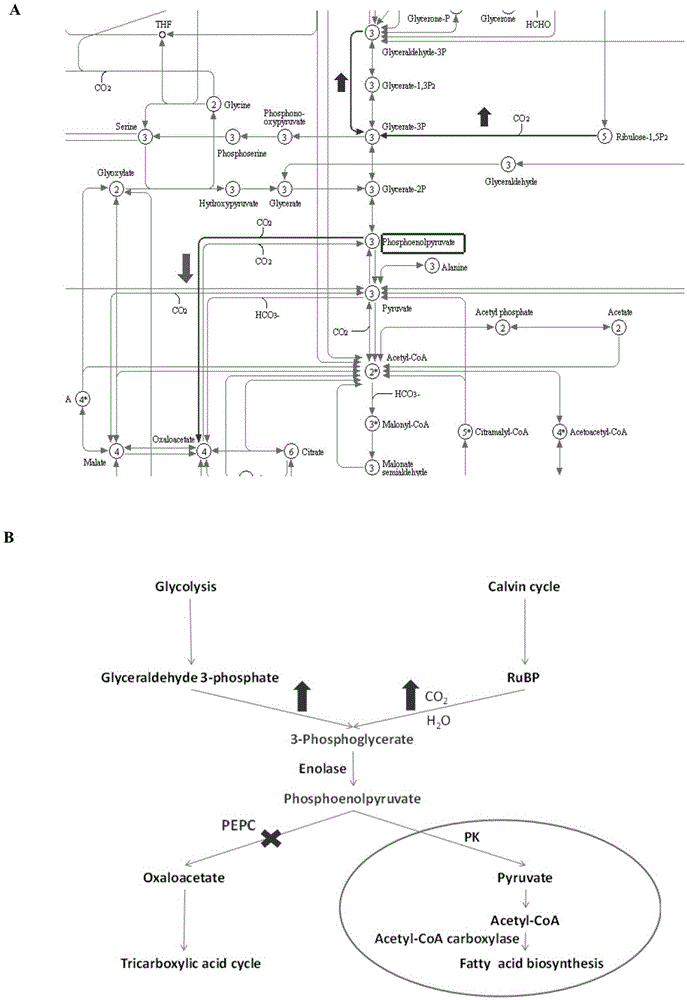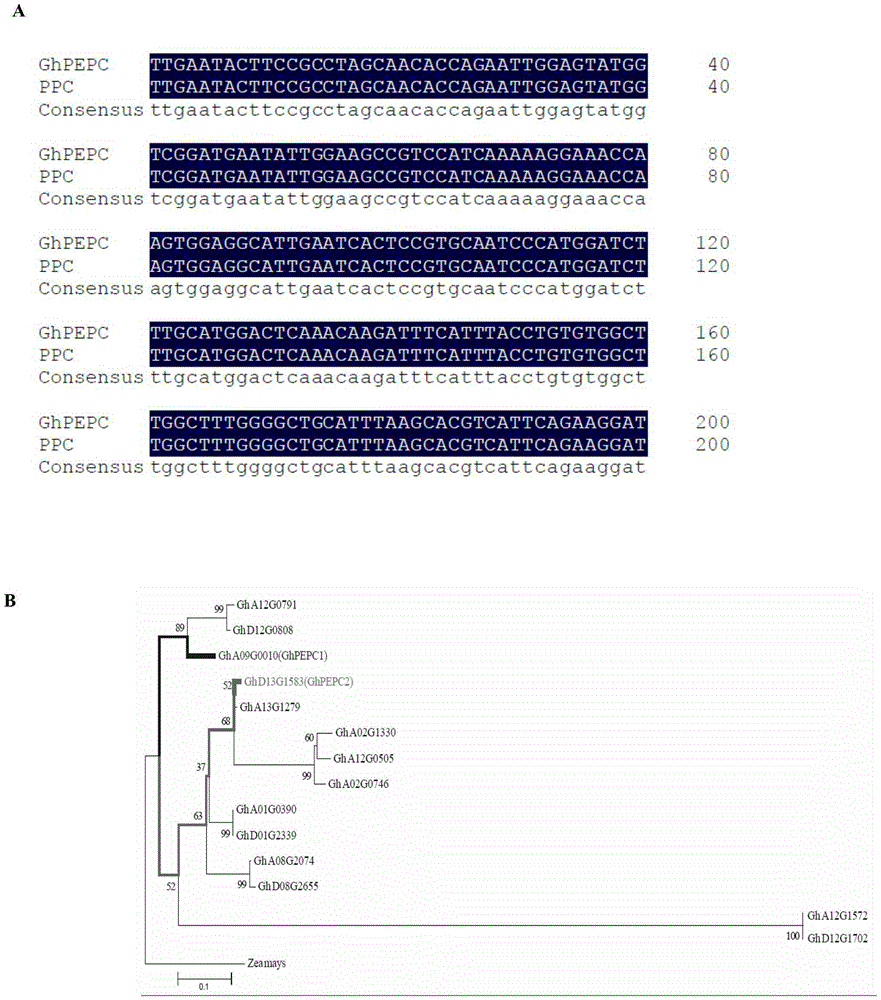Method of creating high-oil cotton material by using cotton GhPEPC gene
A gene and cotton technology is applied in the field of using cotton GhPEPC gene to create cotton high-oil materials, which can solve the problems of low silencing efficiency, and achieve the effects of reducing protein content, increasing content and reducing synthesis.
- Summary
- Abstract
- Description
- Claims
- Application Information
AI Technical Summary
Problems solved by technology
Method used
Image
Examples
Embodiment 1
[0060] Cloning of Example 1 GhPPC Gene
[0061] The applicant cloned a 308bp sequence from upland cotton (Gossypium hirsutum) [The primers used are: GhPPC-F: (5'-TTGAATACTTCCGCCTAGCA-3'), GhPPC-R: (5'-AGCGATTCCAGGGTCTCC-3') 】. Perform TA cloning and sequencing on the obtained DNA fragments, and compare with the sequence on NCBI to verify whether it is the GhPPC gene sequence (see figure 1 Figure A in the figure), and at the same time, we carried out evolutionary analysis on the homologous genes of the GhPPC gene in cotton, and found that there were multiple copies, and we selected two of the copies as the targets of RNA interference, namely the GhPPC1 and GhPPC2 genes (see figure 1 in panel B).
[0062] 1. Extraction of total RNA from upland cotton leaves (improved guanidine isothiocyanate method) and cDNA acquisition:
[0063] Modified guanidine isothiocyanate method:
[0064] 1.1 Grind fresh leaves or leaves frozen at -70 degrees into powder with liquid nitrogen, weigh 0...
Embodiment 2
[0077] Embodiment 2: the construction of GhPPC gene plant interference vector
[0078] According to the obtained SEQ ID NO: 1, primers were designed for constructing expression vectors, and linker bases for BP reaction were added to both ends of the primers respectively. The primer sequences were GhPPC-BP-F: (5'-GGGG ACA AGT TTG TAC AAA AAA GCA GGC TNNTTGAATACTTCCGCCTAGCA-3'), GhPPC-BP-R: (5'-GGGG AC CAC TTT GTA CAA GAAAGC TGG GTNAGCGATTCCAGGGTCTCC-3'). The pGEM-T-GhPPC plasmid was used as a template for PCR amplification. The PCR conditions were 95°C for 5 min; 95°C for 30 sec, 55°C for 30 sec, 72°C for 20 sec, and 32 cycles; 72°C for 10 min. The correct GhPPC fragment containing BP linker was obtained by PCR amplification. The PCR product was connected to the pHellsgate 4 carrier by BP reaction (BP enzyme was purchased from Invitrogen, the United States, 25°C for 4 hours), and then transformed into Escherichia coli Top10 competent cells, and GhPPC-specific primers (GhPPC-F ...
Embodiment 3
[0079] Embodiment 3 Genetic transformation and screening identification of GhPPC gene
[0080] 1. Preparation of sterile vaccine
[0081] The test material is wild type upland cotton YZ1 (Yuzao 1, Cotton Research Institute, Chinese Academy of Agricultural Sciences). Sowing cotton aseptic seedlings under in vitro culture conditions: sterilize the shelled seed kernels with 0.1% mercuric chloride for 8 minutes on the ultra-clean workbench, and then wash them with sterile water for 3-4 times, and the resulting sterile seedlings Kernels (or explants) are inoculated in the aseptic seedling medium, the seedlings are supported after 2 days, the seed coat is removed, and hypocotyls can be obtained after 5 days.
[0082] 2. Activation and infection of Agrobacterium
[0083] Take out the stored expression vector p35S-GhPPC containing the target gene from the ultra-low temperature refrigerator, transform Agrobacterium LBA4404 by electric shock, and apply spe + Resistance, single clones...
PUM
 Login to View More
Login to View More Abstract
Description
Claims
Application Information
 Login to View More
Login to View More - R&D
- Intellectual Property
- Life Sciences
- Materials
- Tech Scout
- Unparalleled Data Quality
- Higher Quality Content
- 60% Fewer Hallucinations
Browse by: Latest US Patents, China's latest patents, Technical Efficacy Thesaurus, Application Domain, Technology Topic, Popular Technical Reports.
© 2025 PatSnap. All rights reserved.Legal|Privacy policy|Modern Slavery Act Transparency Statement|Sitemap|About US| Contact US: help@patsnap.com



